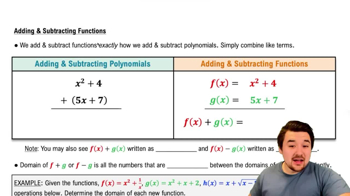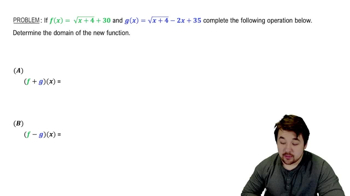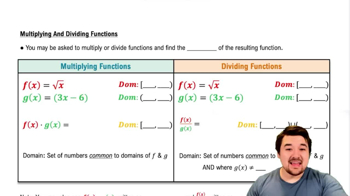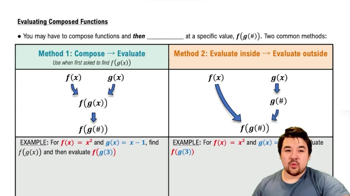Table of contents
- 0. Functions7h 52m
- Introduction to Functions16m
- Piecewise Functions10m
- Properties of Functions9m
- Common Functions1h 8m
- Transformations5m
- Combining Functions27m
- Exponent rules32m
- Exponential Functions28m
- Logarithmic Functions24m
- Properties of Logarithms34m
- Exponential & Logarithmic Equations35m
- Introduction to Trigonometric Functions38m
- Graphs of Trigonometric Functions44m
- Trigonometric Identities47m
- Inverse Trigonometric Functions48m
- 1. Limits and Continuity2h 2m
- 2. Intro to Derivatives1h 33m
- 3. Techniques of Differentiation3h 18m
- 4. Applications of Derivatives2h 38m
- 5. Graphical Applications of Derivatives6h 2m
- 6. Derivatives of Inverse, Exponential, & Logarithmic Functions2h 37m
- 7. Antiderivatives & Indefinite Integrals1h 26m
- 8. Definite Integrals3h 25m
0. Functions
Combining Functions
Problem 1.1.68
Textbook Question
Simplify the difference quotient ƒ(x+h)-ƒ(x)/h
ƒ(x) = (x)/(x+1)
 Verified step by step guidance
Verified step by step guidance1
Identify the function f(x) = x/(x+1) and write down the difference quotient formula: (f(x+h) - f(x))/h.
Calculate f(x+h) by substituting x+h into the function: f(x+h) = (x+h)/(x+h+1).
Substitute f(x+h) and f(x) into the difference quotient: ((x+h)/(x+h+1) - (x/(x+1)))/h.
Combine the fractions in the numerator by finding a common denominator, which is (x+h+1)(x+1).
Simplify the resulting expression by factoring and reducing, if possible, to express the difference quotient in its simplest form.
Recommended similar problem, with video answer:
 Verified Solution
Verified SolutionThis video solution was recommended by our tutors as helpful for the problem above
Video duration:
4mPlay a video:
Was this helpful?

 5:56m
5:56mWatch next
Master Adding & Subtracting Functions with a bite sized video explanation from Nick
Start learning




